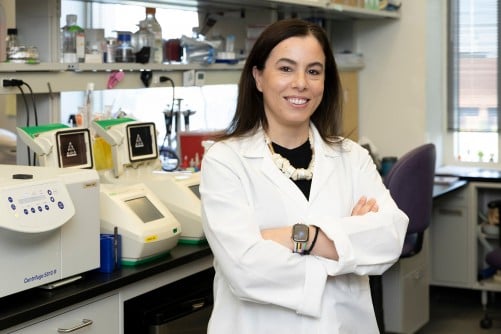Research at the University of Illinois Chicago has revealed a crucial mechanism behind cellular aging, particularly in blood stem cells. The study, published in the journal Blood, identifies a decline in a protein known as platelet factor 4 as a significant factor in the aging process of these vital cells. This discovery opens doors to potential therapeutic strategies for age-related disorders affecting the blood and immune systems.
As individuals age, they often experience not only physical changes, such as graying hair and muscle weakness, but also alterations in their immune system. Specifically, stem cells responsible for generating blood and immune cells can develop mutations, which may lead to conditions like cancer or other dysfunctions. The research team, guided by Sandra Pinho, an associate professor of pharmacology and regenerative medicine, focused on hematopoietic stem cells, which reside in bone marrow and give rise to essential blood components.
Pinho describes these stem cells as the “Holy Grail of the immune system.” In younger individuals, these cells can efficiently produce both myeloid cells—responsible for immune responses and oxygen transport—and lymphoid cells, which include T and B cells that defend against infections. However, as the body ages, there is a noticeable shift in the production of these cells. Hematopoietic stem cells tend to generate more myeloid cells while producing fewer lymphoid cells, leading to a less effective immune response in older adults.
The researchers utilized samples from both aged mice and human bone marrow to investigate the role of platelet factor 4 in the aging process. They found that in younger organisms, this protein serves as a critical regulator, instructing hematopoietic stem cells to cease excessive division, thus preventing uncontrolled proliferation. As age progresses, the production of platelet factor 4 diminishes, resulting in increased cell division and a higher likelihood of accumulating mutations.
“Excessive division of stem cells can lead to mutations that may result in inflammation, an increased risk of blood cancers, and even cardiovascular diseases,” Pinho explained.
Remarkably, the research team found that introducing platelet factor 4 to older mice reversed the signs of aging in their hematopoietic stem cells. Over a month, the animals received daily blood infusions of the protein, which led to significant rejuvenation in their immune and blood cells. Similar results were observed when the protein was applied to older human stem cells in laboratory experiments. “It rejuvenated the aging of the blood system,” Pinho said.
While the effects of platelet factor 4 are promising, Pinho cautions against viewing it as a standalone solution for reversing aging across all tissues. Instead, it could serve as an important component in a broader strategy to combat age-related diseases. “This research provides clear evidence that it is possible to intrinsically reverse certain age-associated disorders,” she remarked.
The study’s first author, Sen Zhang, a postdoctoral fellow in Pinho’s lab, collaborated closely with Constantinos Chronis from the Department of Biochemistry and Molecular Genetics, who also served as a co-corresponding author. Other contributors from the University of Illinois Chicago include Charles Ayemoba, Anna Di Staulo, Kenneth Joves, Chandani Patel, Eva Leung, Maura Bueno, Xiaoping Du, and Sang-Ging Ong.
This groundbreaking research underscores the importance of understanding the cellular mechanisms that govern aging and highlights potential avenues for therapeutic interventions to enhance health in older populations. As the global demographic continues to shift towards an aging population, such discoveries hold significant promise for improving quality of life and longevity.
